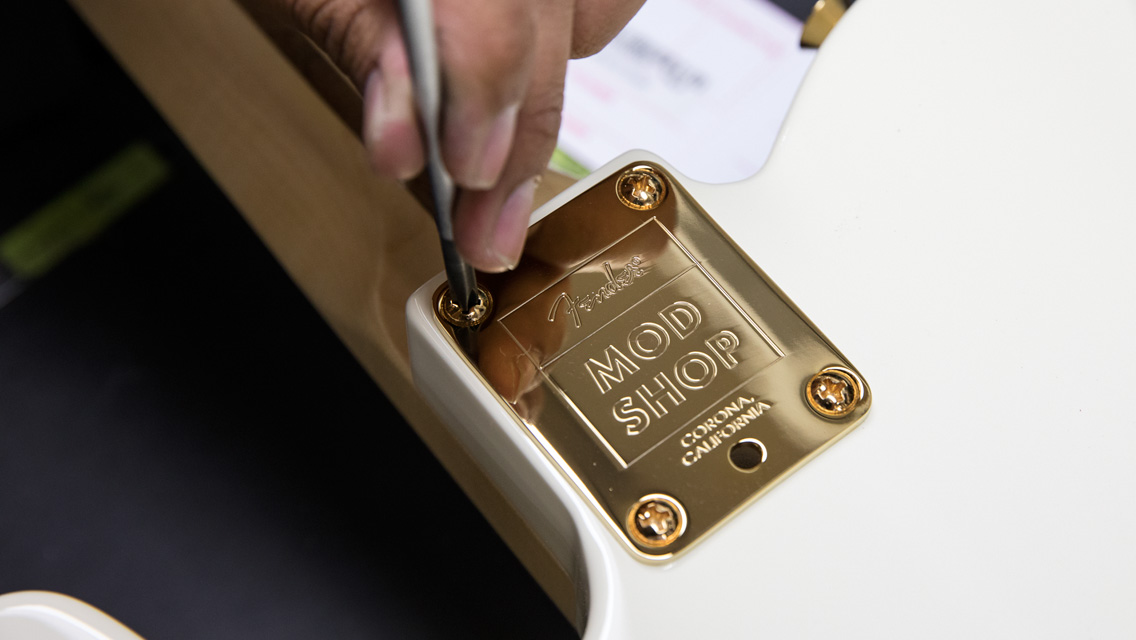
Bass guitar, for sure.
The Bass VI, recently resurrected in hot-rodded form by Fender and in its classic form by Squier, is a six-string bass guitar. It was designed and offered as a special kind of bass guitar during its original run from 1961 to 1975, and it is designed and offered as such today. It is not a baritone guitar.
Then what’s the difference between the Bass VI and a baritone guitar? If it isn’t a semantic matter of two names for the same thing —as some suppose — what distinguishes one from the other?
Baritone guitars are considered just that—guitars. They’re strung with guitar strings, and they have a scale length usually somewhere around 27”, which is between the standard scale lengths for a guitar (around 25”) and a bass guitar (usually 34”; around 30” for short-scale and 32” for medium-scale models). Baritone guitars almost never use standard guitar tuning (EADGBE). Rather, they’re usually tuned a fourth lower than a guitar (BEADF#B), with the fifth-string E matching the sixth-string low E on a standard guitar. Baritone guitars are sometimes tuned a fifth (ADGCEA) or even a major third lower (CFBbEbGC) than standard guitar tuning.
The current Fender and Squier Bass VI models are considered bass guitars, as was the Fender original. They’re strung with bass strings, albeit a special set made specifically for the model. They have a 30” scale length, like most short-scale basses, and they use standard tuning (EADGBE) one octave lower than a guitar.
You could use alternate tunings on the Bass VI if you wanted to, but that wouldn’t make it a baritone guitar; it’d just be, well, a Bass VI with another tuning. And the converse would be pointlessly impractical — slapping a set of bass strings on a baritone guitar probably isn’t going to work because bass strings will likely be too floppy on a 27”-scale instrument to be of any use, and the tuners would likely be too small to be able to accommodate bass guitar strings anyway.
So it really isn’t just a matter of semantics. As Fender has always intended and characterized its Bass VI, the terms “six-string bass guitar” and “baritone guitar” are not interchangeable. Although the differences might seem subtle to some, they’re definitely two different kinds of instruments.
In the few instances when Fender has offered true baritone electric guitars, they’ve been billed as just that; i.e., the Sub-Sonic Baritone Stratocaster of 2000-2002, the Jaguar Baritone Special HH of 2005-2010 and the Blacktop Telecaster Baritone of 2012-present. All three instruments have a 27” scale.
To reiterate, however, Bass VI models old and new are considered bass guitars and have always been billed as such by Fender.
Incidentally, the new Bass VI models don’t say “Bass VI” on the headstock. They say “Fender VI” and “Squier VI” on their headstocks, respectively. This is in keeping with the style of the original instrument, which said “Fender VI” on its headstock even though it was first billed in the 1961 Fender catalog as simply a “New Fender bass guitar” and as the “Bass VI guitar” and “Bass VI” in subsequent catalogs throughout the rest of the 1960s and into the 1970s.
Do you want to learn more about your guitar? Check out these informative videos from Fender Play. And if you're not a member of Fender Play yet, click here for a free trial.
Don’t miss out!
Be the first to know about new products, featured content, exclusive offers and giveaways.


